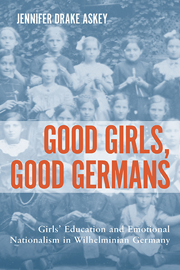Book contents
- Frontmatter
- Dedication
- Contents
- Acknowledgments
- Introduction: Emotional Nationalism and Germany’s Daughters
- 1 Nationalist Education and Prussia's höhere Töchter
- 2 Father's Library: German Classics in Girls' Schools and the Ownership of German Culture
- 3 Mädchenliteratur I—Backfischbücher and Historical Novels
- 4 Mädchenliteratur II—Queen Luise
- Conclusion
- Bibliography
- Index
4 - Mädchenliteratur II—Queen Luise
Published online by Cambridge University Press: 05 August 2013
- Frontmatter
- Dedication
- Contents
- Acknowledgments
- Introduction: Emotional Nationalism and Germany’s Daughters
- 1 Nationalist Education and Prussia's höhere Töchter
- 2 Father's Library: German Classics in Girls' Schools and the Ownership of German Culture
- 3 Mädchenliteratur I—Backfischbücher and Historical Novels
- 4 Mädchenliteratur II—Queen Luise
- Conclusion
- Bibliography
- Index
Summary
Luise of Prussia, wife of Friedrich Wilhelm III, Queen of Prussia from 1797 until her death in 1810, was a popular subject for historical novels and biographies for young women. Her life story could easily be told in terms of the fairy tale and classical romance, from her comparatively modest childhood as a princess of Mecklenburg-strelitz whose mother died when she was merely six years old, to her triumphant entrance into Berlin and her marriage to Crown Prince Friedrich Wilhelm III, ending with her early death at thirty-four at the end of her family's exile from Prussia during Napoleon's occupation. Told and retold, Luise's life from her earliest days was memorialized—and fictionalized—as a lesson in history and femininity for Germany's young women.
Novels and biographies that sought to develop a personal connection between the höhere Töchter of the late nineteenth century and the historical Luise enjoyed widespread popularity and pedagogical approval for a number of reasons. Luise's short life spanned the era from the coronation of the last two emperors of the Holy Roman Empire of the German Nation (Leopold II, 1790, and Franz II, 1792) to the European domination of Napoleon. After her death, her husband led Prussian troops to victory over the French emperor, and her second son, Wilhelm, defeated the French again, becoming, in his old age, the first emperor of Germany.
- Type
- Chapter
- Information
- Good Girls, Good GermansGirls' Education and Emotional Nationalism in Wilhelminian Germany, pp. 143 - 182Publisher: Boydell & BrewerPrint publication year: 2013



